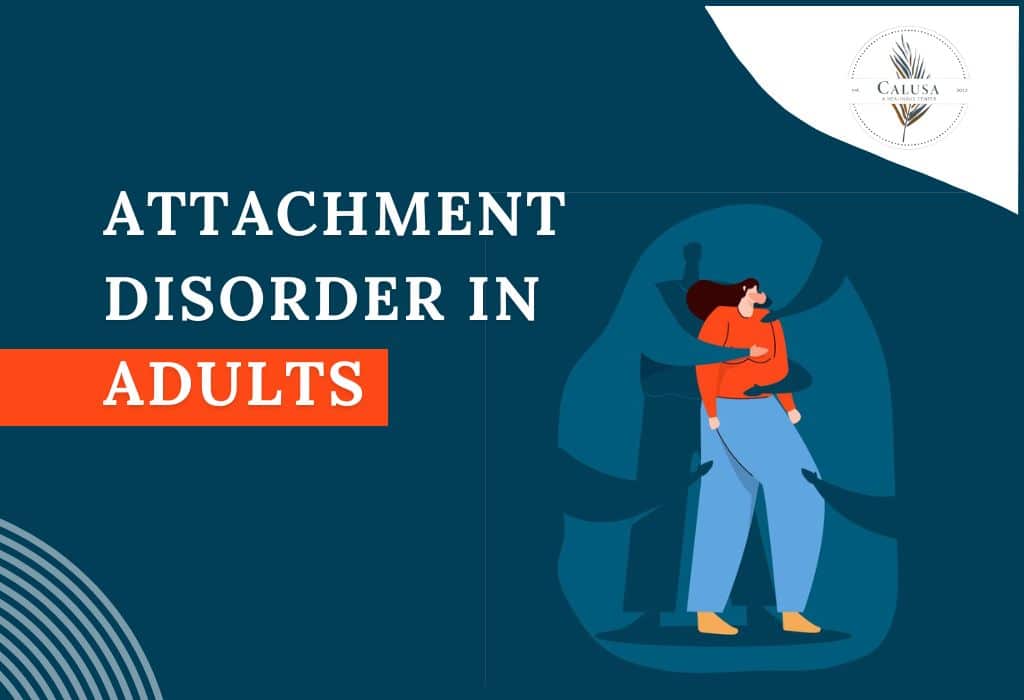Have you ever felt a deep-seated fear of intimacy, a constant struggle to trust others or a confusing mix of wanting closeness and pushing people away? These experiences may be signs of attachment disorder, a condition that can significantly impact adult relationships.
In childhood, attachment issues can persist well into adulthood, affecting our ability to connect with others on an emotional level. Understanding attachment disorder is crucial for fostering healthy, fulfilling relationships.
Many adults struggle with attachment issues without realizing it.
This lack of awareness can lead to a cycle of unhealthy relationships, loneliness, and emotional pain.
This blog aims to provide a comprehensive guide to attachment disorder in adults. We’ll explore the different types of attachment styles, how to identify attachment issues in yourself, and most importantly, explore effective healing strategies.
What is Attachment Disorder?
Attachment disorder is a general term for a pattern of emotional and behavioral problems that stem from disrupted or inconsistent caregiving experiences in early childhood. These experiences prevent children from forming secure and trusting attachments with their primary caregivers.
Explanation of how it develops
Foundation of Attachment: Crucial in the first few years; consistent, responsive caregiving is vital.
Neglect and Abuse: Hinders secure attachments; frequent caregiver changes are also detrimental.
Emotional Support: Essential for emotion regulation; emotionally unavailable caregivers impede development.
Differences Between Attachment Disorder in Children and Adults
- Children: Difficulty bonding, clinginess, anxiety, depression, aggression.
- Adults: Relationship challenges, trust issues, fear of abandonment, emotional detachment, dependency.
Understanding attachment disorder is crucial for recognizing its effects and seeking appropriate treatment to foster healthier relationships.
Attachment Theory
Attachment theory explains how early relationships with caregivers shape an individual’s ability to form secure bonds and manage emotions throughout life. It emphasizes the importance of a child’s relationship with their primary caregiver in developing a sense of security and stability.
Key figures and foundational research
John Bowlby: Known as the father of attachment theory, Bowlby proposed that children are biologically programmed to form attachments with caregivers for survival, emphasizing the need for a secure base for exploration.
Mary Ainsworth: Built on Bowlby’s work with her “Strange Situation” study, identifying attachment styles (secure, anxious-ambivalent, and avoidant) and providing empirical support for Bowlby’s theories.
How Attachment Theory Applies to Adult Relationships
Attachment theory extends beyond childhood, influencing how adults form and maintain relationships. The attachment styles identified in childhood often persist into adulthood, affecting romantic relationships, friendships, and professional interactions.
For example:
- Secure Attachment: Healthy, trusting relationships; balance intimacy and independence.
- Anxious-Ambivalent Attachment: Seek constant reassurance; insecure and fear abandonment.
- Avoidant Attachment: Struggle with intimacy; emotionally distant; prefer independence.
Understanding attachment theory helps in recognizing the roots of relationship dynamics and addressing issues stemming from early attachment experiences.
Causes of Attachment Disorder in Adults
Early Childhood Experiences
When children do not form secure bonds with their primary caregivers during early development, they may struggle with attachment issues later in life. Consistent, responsive caregiving is crucial during this period.
Trauma and Neglect
- Abuse: Severely impacts attachment; physical, emotional, or sexual abuse hinders secure bonds.
- Neglect: Deprivation of emotional support leads to attachment disorders and reliance on self for comfort and security.
Inconsistent Caregiving
- Unstable Environments: Frequent changes in caregivers hinder stable attachment patterns.
- Inconsistent Responses: Uncertainty and anxiety result from caregivers’ unpredictability.
Genetic and Environmental Factors:
- Inherited Traits: Genetic predisposition affects emotional regulation and temperament, impacting attachment.
- Environmental Influences: Socioeconomic status, family dynamics, and community support shape attachment development.
Understanding these causes helps in identifying and addressing the root issues of attachment disorders in adults, paving the way for effective treatment and healing.
Symptoms of Attachment Disorder in Adults
Adults with attachment disorder often exhibit a range of emotional and behavioral symptoms that stem from early disrupted or inconsistent caregiving. They may experience emotional detachment, finding it difficult to form deep emotional bonds and often feeling disconnected or numb in relationships. These individuals also struggle with forming and maintaining relationships, frequently facing challenges initiating or sustaining intimate connections, leading to frequent breakups or social isolation.
- Emotional Detachment: Struggle to form deep emotional bonds, feeling disconnected or numb.
- Difficulty Forming and Maintaining Relationships: Challenges in initiating or sustaining intimate relationships, leading to breakups or isolation.
- Anxiety and Fear of Abandonment: Persistent worry about abandonment, causing clinginess or dependency.
- Trust Issues: Difficulty trusting others, leading to suspicion and reluctance to rely on anyone.
- Impulsive or Controlling Behavior: Impulsivity or a need to control situations to avoid vulnerability.
Types of Attachment Styles
Attachment styles in adults, rooted in early childhood experiences, significantly influence how individuals interact in relationships. There are four primary attachment styles: secure, anxious-preoccupied, dismissive-avoidant, and fearful-avoidant. Adults with a secure attachment style typically enjoy healthy, trusting relationships, balancing intimacy with independence. Those with an anxious-preoccupied attachment style often seek constant reassurance and fear abandonment, leading to clinginess and insecurity.
Below are the types of Attachment Styles:
Secure Attachment:
- Healthy relationships
- Trusting and balanced
- Comfortable with intimacy and independence
Anxious-Preoccupied Attachment:
- The constant need for reassurance
- Fear of abandonment
- Clinginess and insecurity
Dismissive-Avoidant Attachment:
- Emotional distance
- Prioritizes independence
- Struggles with intimacy
Fearful-Avoidant Attachment:
- Fear of intimacy and abandonment
- Unpredictable and unstable relationships
- Mixed feelings
Impact on Relationships
In adulthood, attachment styles significantly influence behaviors and relationship dynamics. Securely attached adults are open, communicative, and balance intimacy with independence. Anxious-preoccupied individuals exhibit neediness and anxiety, becoming overly dependent on partners and constantly seeking reassurance. Dismissive-avoidant adults are detached and self-reliant, prioritizing independence over intimacy. Fearful-avoidant individuals display ambivalence and anxiety, leading to unstable relationships due to fears of both intimacy and abandonment. Recognizing these behaviors helps address attachment-related relationship challenges effectively.
- Romantic Relationships: Attachment disorders cause jealousy, dependency, mistrust, and difficulties in maintaining long-term connections.
- Friendships and Family Dynamics: Difficulty forming deep bonds leads to superficial friendships and strained family relationships.
- Workplace and Social Settings: Trust issues and emotional detachment hinder teamwork, leadership, and social interactions, leading to professional difficulties and isolation.
Understanding these symptoms, attachment styles, and their impact on relationships helps recognize attachment disorders and seek appropriate treatment to foster healthier personal and professional interactions.
Diagnosis of Attachment Disorder in Adults
Diagnosing attachment disorder in adults involves assessing symptoms such as emotional detachment, relationship struggles, anxiety, and trust issues. Mental health professionals play a key role in this process, utilizing clinical interviews, observation, and psychological assessments to determine the presence and severity of attachment-related issues. Various assessment tools and techniques, including standardized tests and the Adult Attachment Interview (AAI), are employed to gain insights into individuals’ attachment patterns and early caregiving experiences.
- Criteria: Assessing symptoms and identifying behavior patterns.
- Role of Professionals: Conducting clinical interviews and observations.
- Assessment Tools: Using questionnaires and standardized tests.
Treatment Options
Treatment options for attachment disorders include psychotherapy, medication, and group therapy. Psychotherapy, such as cognitive-behavioral therapy (CBT) and attachment-based therapy, focuses on addressing underlying attachment issues, improving relationship skills, and promoting emotional healing.
- Psychotherapy: Cognitive-behavioral therapy (CBT) and attachment-based therapy for emotional healing and improving relationship skills.
- Medication: Antidepressants or anti-anxiety medication to alleviate symptoms.
- Group Therapy: Supportive sessions for sharing experiences and learning coping strategies.
Coping Mechanisms
Coping mechanisms for attachment-related challenges encompass various strategies to foster emotional well-being and resilience. These include developing healthy relationships and boundaries, which provide a sense of security and support. Mindfulness and stress reduction techniques, such as meditation and relaxation exercises, aid in regulating emotions and reducing stress levels. Building self-awareness and emotional regulation skills enhances the ability to manage difficult emotions effectively.
- Healthy Relationships: Establish boundaries and foster support for emotional security.
- Mindfulness Techniques: Practice meditation and relaxation for emotional regulation.
- Self-Awareness: Develop skills to manage emotions effectively.
- Seek Support: Get help from friends, family, and professionals.
Conclusion
In conclusion, recognizing and addressing attachment disorder in adults is crucial for fostering healthy, fulfilling relationships and overall well-being. Through understanding the root causes, symptoms, and impact on relationships, individuals can seek appropriate treatment options to heal and improve their quality of life.
Remember, healing is a journey, and you deserve to experience fulfilling connections and emotional security. Take the first step towards healing today and prioritize your mental health and well-being.
If you or someone you know is struggling with attachment disorder, don’t wait. Reach out to Calusa for support and guidance on the path to healing. Your journey to healthier relationships starts now.
FAQs
Que: Can attachment disorder develop in adulthood?
Ans: Yes, attachment disorder can develop in adulthood, especially if there are disruptions or inconsistencies in early caregiving experiences. These attachment issues can persist into adulthood and affect relationships.
Que: How can I help a partner with attachment disorder?
Ans: Supporting a partner with attachment disorder involves understanding their needs, being patient, and encouraging them to seek professional help. Providing a safe and supportive environment can also facilitate healing and growth.
Que: Is attachment disorder hereditary?
Ans: While there may be genetic factors that contribute to difficulties with attachment, attachment disorder is primarily influenced by early caregiving experiences and environmental factors.
Que: Can attachment disorder be completely cured?
Ans: While attachment disorder may not be completely cured, individuals can learn coping mechanisms, develop healthier attachment patterns, and improve their relationships through therapy and support. Early intervention and consistent treatment can lead to significant improvements.
Que: What should I do if I suspect I have attachment disorder?
Ans: If you suspect you have attachment disorder, it’s essential to seek help from a mental health professional. They can assess your symptoms, provide a diagnosis, and recommend appropriate treatment options tailored to your needs. Don’t hesitate to reach out for support and guidance on your journey to healing.










